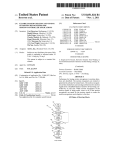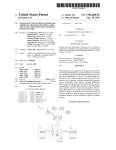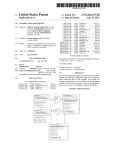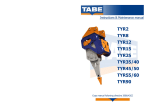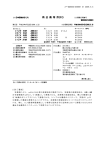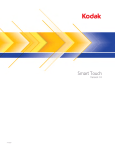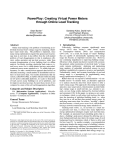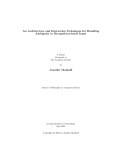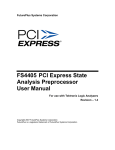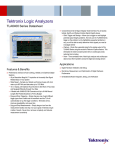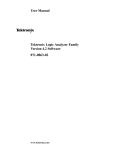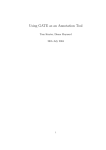Download Method and system for tuning motion recognizers by a user using a
Transcript
US007899772B1 (12) United States Patent (10) Patent N0.: (45) Date of Patent: Bererton et al. (54) (56) METHOD AND SYSTEM FOR TUNING 6,249,606 7,421,369 7,519,223 7,580,572 Inventors: Curt Bererton, Burlingame, CA (US); (US); Xiaoyuan Tu, Sunnyvale, CA (US); Ian Wright, Sunnyvale, CA (US); Wei Yen, Seattle, WA (US) U.S. PATENT DOCUMENTS Bl 6/2001 Kiraly et a1. B2 B2 B2 7,702,608 B1 7,770,136 B2 7,774,155 B2 Daniel Dobson, Atherton, CA (US); John Funge, Sunnyvale, CA (US); Charles Musick, Jr., Belmont, CA (US); Stuart Reynolds, Mountain View, CA *Mar. 1, 2011 References Cited MOTION RECOGNIZERS BY A USER USING A SET OF MOTION SIGNALS (75) US 7,899,772 B1 2004/0030531 A1 2005/0215322 A1 2005/0219213 A1 9/2008 4/2009 8/2009 4/2010 8/2010 8/2010 2/2004 9/2005 10/2005 Clarkson Dehlin et al. Bang et al. Bererton et al. Beeck et a1. Sato et a1. Miller et al. Himoto et al. Cho et al. (Continued) (73) Assignee: AiLive, Inc., Mountain View, CA (US) Notice: FOREIGN PATENT DOCUMENTS Subject to any disclaimer, the term of this patent is extended or adjusted under 35 EP 1834680 A2 9/2007 (Continued) USC 154(b) by 0 days. OTHER PUBLICATIONS This patent is subject to a terminal dis claimer. E. Keogh and M. Pazzani, Derivative Dynamic Time Warping, in First SIAM International Conference on Data Mining, (Chicago, IL, 2001). (21) Appl. No.: 12/715,397 (22) Filed: (Continued) Primary Examiner * Donald Sparks Mar. 2, 2010 Assistant Examiner * Ben M Ri?<in Related US. Application Data (63) (51) Continuation of application No. 11/486,997, ?led on Jul. 14, 2006, noW Pat. No. 7,702,608. Int. Cl. G06F 17/00 G06F 19/00 G06N 5/02 A63F 9/24 A63F 13/00 (52) (58) (74) Attorney, Agent, or Firm * Joe Zheng (57) ABSTRACT Techniques for using motion recognizers are described. The motion recognizers are created or generated in advance by trained users. The motion recognizers are then loaded into a processing unit that receives motion signals from one or more (2006.01) (2006.01) (2006.01) (2006.01) (2006.01) motion sensitive devices being manipulated by one or more end users to control one or more objects in a virtual environ ment. Depending on implementation, the virtual environment may represent a remote scene or a video game, Where objects US. Cl. ........................................... .. 706/46; 463/37 Field of Classi?cation Search ................... .. 706/46 in the virtual environment can be controlled by the users to perform desired actions or moves. See application ?le for complete search history. 36 Claims, 6 Drawing Sheets classi?ers LiveMove library console development kit \ .................... .. ....................... ./ Overview. US 7,899,772 B1 Page 2 US. PATENT DOCUMENTS 2006/0071904 A1 4/2006 Cho et al. 2006/0279549 A1 12/2006 Zhang et al. 2006/0287084 A1 12/2006 Mao et al. 2009/0066641 2009/0143141 2009/0149257 2009/0209343 2009/0258703 2009/0265671 2009/0273559 3/2009 6/2009 6/2009 8/2009 10/2009 10/2009 11/2009 A1 A1 A1 A1 A1 A1 A1 2009/0291759 A1 2010/0035688 A1 2010/0079447 A1 Mahajan et al. Wells et al. Ferguson et al. Foxlin et al. Brunstetter Sachs etal. Rofougaran et al. 11/2009 Cox et al. 2/2010 Picunko 4/2010 Williams 2010/0088061 A1 2010/0117959 A1 4/2010 Horodezkyet al. 5/2010 Hongetal. 2010/0171696 A1 2010/0201616 A1 7/2010 Wu 8/2010 Choietal. FOREIGN PATENT DOCUMENTS EP GB JP WO WO 2090346 A1 2423808 11253656 WO2006/090197 WO2006/128093 8/2009 9/2006 9/1999 8/2006 11/2006 R. Kj eldson and J. Kender, Towards the Use of Gesture in Traditional User Interfaces, Proceedings of the 2nd International Conference on Automatic Face and Gesture Recognition) 1996. D. Kwon and M. Gross, Combining Body Sensors andVisual Sensors for Motion Training, ACM SIGCHI ACE 2005. Liqun Deng et al, “Automated Recognition of Sequential Patterns in Captured Motion Streams”, WAIM 2010, LNCS 6184, pp. 250-261, 2010. M. Roth, K. Tanaka, “Computer Vision for Interactive Computer Graphics”, TR99-02 Jan. 1999,1EEE Computer Graphics andAppli cations, May-Jun. 1998, pp. 42-53. YK Jung, et al, “Gesture recognition based on motion inertial sensors for ubiquitous interactive game content”, IETE Technical review, vol. 27, Issue 2, Mar.-Apr. 2010. Zhang Xu et al, “Hand Gesture Recognition and Virtual Game Con trol Based on 3D Accelerometer and EMG Sensors”, I U] '09, Feb. 8-11, 2009, Sanibel Island, Florida, USA. Greg Welch, et al, “Motion Tracking: No Silver Bullet, but a Respect able Arsenal”, Motion Tracking Survey, Nov/Dec. 2002. Axel Mulder, et al, “Human movement tracking technology”, Human Movement Tracking Technology. Technical Report, NSERC Hand Centered Studies of Human Movement project, available through anonymous ftp in fas.sfu.ca:/pub/cs/graphics/vmi/HMTT.pub.ps.Z. Burnaby, BC, Canada: Simon Fraser University. Sven KratZ, et al, “Gesture Recognition Using Motion Estimation on Mobile Phones” Proc PERMID 07 3rd Intl Workshop on Pervasive Mobile Interaction Devices at Pervasive 2007. OTHER PUBLICATIONS Chuck Blanchard, et al, “Reality Built For Two: AVirtual Reality Too Lawrence R. Rabiner, A Tutorial on Hidden Markov Models and City, CA 9406 3, I3D ’90 Proceedings of the 1990 symposium on Interactive 3D graphics, © 1990 table of contents ISBN:0-89791 I” VPL Research, Inc . 656 Bair Island Road, Suite 30 4, Redwood Selected Applications in Speech Recognition. Proceedings of the IEEE, 77 (2), p. 257-286, Feb. 1989. “Radar, Sonar, Navigation & Avionics Strapdown Inertial Naviga tion Technology, 2nd Edition”, by D. Titterton and J. Weston. “Design and Error Analysis ofAccelerometer-Based Inertial Navi 3 51-5. NamHo Kim. et a1 “Gesture Recognition Based on Neural Networks for Dance Game Contents”, 2009 International Conference on New Trends in Information and Service Science. Xiaoxu Zhou, et a1 “Real-time Facial Expression Recognition in the gation Systems”, Chin-Woo Tan et al., Published in Jun. 2002 by the University of California at Berkeley for the State of California PATH ceedings of the International Conference on Computer Graphics, Transit and Highway System. Imaging and Visualization (CGIV’04). Interactive Game Based on Embedded Hidden Markov Model”, Pro US. Patent Mar. 1, 2011 Sheet 1 of6 US 7,899,772 B1 100 LiveMove library console development kit \ _ _ _ _ _ _ _ _ _ _ _ _ _ _ _ _ _ _ _ _ _ _ _ _ _ _ _ _ _ _ _ _ _ _ _ _ _ _ _ Overview. FIG. 1 _ _ _ _ _ __I US. Patent Mar. 1, 2011 Sheet 2 of6 US 7,899,772 B1 201 human performs motion motion ?lter 204 V \\ compute distances to prototypes 205 206 any prototypes Within CD? 207 more than 208 candidate? pick best prototype 210 Classi?cation. FIG. 2 US. Patent Mar. 1, 2011 Sheet 3 of6 US 7,899,772 B1 301 300 \/\ 302\\ labeled motion examples 303 \\ human selects examples to use 304 i calculate classification rates 305 i select best ones as prototypes 306 l build classifier 307 classifiers Generating a Classifier. FIG. 3 US. Patent Mar. 1, 2011 Sheet 4 of6 401 human provides new example 404 adaptive smoothing 405 new example accepted? 406 classifier has spare capacity? 407 add new prototype 408 classifiers Tuning a Classifier. FIG. 4 US 7,899,772 B1 US. Patent Mar. 1, 2011 Sheet 5 of6 US 7,899,772 B1 501 500 \\ \\. host computer 502 504 Console ?ler/A Development kit 505 f 503 Typical Setup. FIG. 5 US. Patent Mar. 1, 2011 Sheet 6 of6 US 7,899,772 B1 600 W 602 + O + O + O + O V E? 604 V 603 605 I _________________ _. I I : 606 classifier #1 classifier #2 l load 5, \\ g ame : I Save, Jill’s classi?er I | . : LlveMove : library | game data ' Ben’s classifier I : : I I __________ _ _C9[1§9|_e__: Tuning setup. FIG. 6 player tuned US 7,899,772 B1 1 2 METHOD AND SYSTEM FOR TUNING MOTION RECOGNIZERS BY A USER USING A SET OF MOTION SIGNALS The invention alloWs a developer to generate motion rec ognizers by providing one or more example motions for each class of motions that must be recognized. Machine learning techniques are then used to automatically generate one or more motion recognizers from the example motions. Those motion recognizers can be incorporated into an end-user application, With the effect that When a user of the application CROSS REFERENCE TO RELATED APPLICATIONS This is a continuation ofU.S. application Ser. No. 11/486, supplies a motion, those motion recognizers Will recognize 997, entitled “Generating Motion Recognizers for Arbitrary the motion as an example of one of the knoWn classes of motion. In the case that the motion is not an example of a Motions”, ?led Jul. 14, 2006, now US. Pat. No. 7,702,608. knoWn class of motion, those motion recognizers can collec BACKGROUND OF THE INVENTION tively recognize that fact by responding that the motion is “unknown”. In another use of the invention, the ability to tune a motion recognizer can be incorporated into an end-user application. 1. Field of the Invention The invention relates to machine learning, especially in the context of generating motion recognizers from example In this case, not just the application developers, but also any motions; in some embodiments, a set of generated motion users of the end-user application can add their oWn neW recognizers can be incorporated into end-user applications, example motions. The recognizer can then be tuned to With the effect that those applications are capable of recog nizing motions. 20 improve recognition rates for sub sequent motions from those 2. Related Art users. Writing program code to recognize Whether a supplied In another use of the invention, the ability to generate or alter a motion recognizer can be incorporated into an end-user motion is an example of one of an existing set of knoWn motion classes, or motion types, can be dif?cult. This is because the representation of a motion can often be counter intuitive. For example, if a motion is created With a device application. In this case, not just the application developers, 25 but also any users of the end-user application can generate their oWn recognizers from any combination of existing containing at least one accelerometer, relating the resulting motions, their oWn neW motions, or both. When the generated data to an intuitive notion of the motion performed can be motion recognizer includes elements of previous motion rec extremely dif?cult With knoWn techniques. The problem is dif?cult because the same motion can be quite different When performed by different people, or even by the same person at ognizers, or is responsive to existing motions, the neWly 30 different times. In addition the motion recording device might ognizers. introduce measurement errors, or noise, that can make it harder to recognize a motion. Handwriting recognition (HWR) is a special case of rec ognizing motions. What makes it a special case is that the set of motion classes is knoWn in advance and all the motions are knoWn ahead of time to be performed in a tWo-dimensional 35 The ability for users of an application to tune or generate their oWn motion recognizers is an enabling technology for a Wide class of applications that, While possibly previously imagined, Were not feasible. Although many potential applications of motion recogni tion are knoWn, the invention is an enabling technology for a plane. For example, in English there are 26 loWercase letters of the alphabet that are Written on a ?at Writing surface. Real generated motion recognizer can be thought of as an alter ation or modi?cation of the previously existing motion rec 40 World HWR recognition systems may include support for uppercase letters, punctuation, numerals and other gestures Wide class of applications. BRIEF DESCRIPTION OF THE DRAWINGS such as cut and paste. At least some machine learning FIG. 1 shoWs the different components of a preferred approaches to HWR are knoWn and Widely used, but they do not solve the more general problem of generating motion recognizers in response to example motions. At least some techniques for gesture recognition of limited symbols in computer games are also knoWn. For example, various spell-casting games alloW players to perform gestures that are recognized as invocations for particular spells. HoW ever, the set of gestures is ?xed in advance by using a pre 50 programmed recognizer. Moreover, a movement is usually embodiment in relation to one another; FIG. 2 shoWs a process of classifying a neW motion; FIG. 3 shoWs a process of generating a neW classi?er in response to a set of labeled examples; FIG. 4 shoWs a process of tuning a classi?er; FIG. 5 shoWs a typical setup that a developer might use When developing a console game; and FIG. 6 shoWs a setup for tuning a classi?er. restricted to movement in a plane. DETAILED DESCRIPTION SUMMARY OF THE INVENTION 55 Generality of the Description The invention provides a Way for developers and users to generate motion recognizers from example motions, Without substantial programming. The invention is not limited to rec ognizing a ?xed set of Well-knoWn gestures, as developers and users can de?ne their oWn particular motions. For This application should be read in the most general pos sible form. This includes, Without limitation, the folloWing: 60 References to speci?c structures or techniques include alternative and more general structures or techniques, espe example, developers and users could choose to give example cially When discussing aspects of the invention, or hoW the motions for their oWn made-up alphabet that is unlike any knoWn alphabet and the invention Will generate a motion invention might be made or used. References to “preferred” structures or techniques gener recognizer for that unique alphabet. The invention is also not limited to motions that occur substantially in a plane, or are substantially prede?ned in scope. 65 ally mean that the inventor(s) contemplate using those struc tures or techniques, and think they are best for the intended application. This does not exclude other structures or tech US 7,899,772 B1 3 4 niques for the invention, and does not mean that the preferred structures or techniques would necessarily be preferred in all circumstances. labeled “waving”. Those skilled in the art would immediately recogniZe that some convenient synonym, such as an integer or enum in a programming language, could be used. Labeled motion: A labeled motion includes a (raw or pro References to ?rst contemplated causes and effects for some implementations do not preclude other causes or effects cessed) motion signal that has been assigned a class label. During the training phase in which a classi?er is generated, labels might be assigned by a human operator or other inter face with domain knowledge of the motion signals. Labels that might occur in other implementations, even if completely contrary, where circumstances would indicate that the ?rst contemplated causes and effects would not be as determina tive of the structures or techniques to be selected for actual use. can also be implicit in the sense that a set of motions grouped together in some way can sometimes be assumed to all References to ?rst reasons forusing particular structures or techniques do not preclude other reasons or other structures as positive examples of some motion that may or may not or techniques, even if completely contrary, where circum have some additional way of describing it. examples of some motion. That is, they are implicitly labeled stances would indicate that the ?rst reasons and structures or Training set: A set of (raw or processed) motion signals techniques are not as compelling. In general, the invention used to generate a motion recogniZer. There are a wide variety of possible forms a training set can take and many structures that a training set can have. For example, not intended to be limiting in any way, a collection of sets of motion classes, or includes those other reasons or other structures or techniques, especially where circumstances indicate they would achieve the same effect or purpose as the ?rst reasons or structures or techniques. a set of labeled motions, or a collection of unlabeled motions After reading this application, those skilled in the art would see the generality of this description. 20 (implicitly assumed to be positive examples of some motion class). Classi?cation rate: A measure of motion recogniZer per De?nitions formance responsive to a set of statistical measures, such as for example a number of false positives and false negatives. The general meaning of each of these following terms is 25 Classi?cation distance: If a set of motions is arranged in ascending order of distance to some particular motion, a classi?cation distance for the particular motion is the distance to the ?rst false positive in that set. 30 belled motion signal or prototype, including the possibility that the assigned class label might be “unknown”, “undeter intended to be illustrative and not in any way limiting. Motion: The action or process of changing position. This includes intentional and meaningful motions, such as twist Classi?cation: Includes assigning a class label to an unla ing ones wrist to simulate using a screwdriver, as well as unintentional motions, such as wobbling some people might exhibit when drunk. Motion signal: A motion signal is information, such as time mined”, and the like. Classi?cation might additionally assign series data that describes some motion over a prede?ned time. The data can take many forms. For example, not intended to probabilities, possibly in response to additional factors, that an unlabelled example is an example of each possible class, in be limiting in any way, positions of an object over time, orientations of an object over time, accelerations experienced by an object over time, forces experienced by an object over 35 time, data expressed in a frequency domain, data expressed in a parameteriZed domain such as R3 or R4, and the like. Motion signals are sometimes referred to as motions. As used herein, a motion signal might refer herein to a processed motion 40 signal or a raw motion signal. which case the assigned label is the class with greatest like lihood. Motion prototype: A motion prototype is a (raw or pro cessed) motion signal that has been chosen to be a member of the set of representative motions for some class of motion signals. The number of prototypes that a motion recogniZer or classi?er can store is called the capacity of the motion recog niZer or classi?er. Processed motion signal: A processed motion signal is a Adaptive smoothing: Adaptive smoothing includes motion motion signal that has been ?ltered or transformed in some ?ltering techniques applied to a raw motion signal to generate way. For example, adaptively smoothing the signal or trans 45 forming the signal into a frequency domain using a Fourier or other transform. Processed motion signals are sometimes referred to herein as processed motions. split into segments and each segment is represented by the average value of the signal in that segment. The length of the segment is determined adaptively according to the magnitude Raw motion signal: Is the unprocessed motion signal. Raw motion signals are sometimes referred to herein as motion a compressed representation, referred to herein as a processed motion signal. In a preferred embodiment, the raw motion is 50 of the underlying raw motion signal. In some embodiments, signals. the length of the segment is proportional the signal magnitude Motion class: A motion class is a set of motions recogniZ able as distinct from other motion classes, such as a cluster of higher magnitude signals intuitively indicate more informa so that the higher the magnitude, the shorter the segmenti motions generally distinguishable from other such clusters. For example, not intended to be limiting in any way, there is a class of motions that correspond to waving. Any two waving motions could be quite different, but there is some group family resemblance that means they are both examples of the tion content and hence the need for a higher sampling rate. 55 motions. Gesture: A meaningful or expressive change in the position class of waving motions. Unknown class: In any set of motion classes there is under stood to be the class of “unknown” or “undetermined” motions. In these cases, the “unknown” class is used herein to refer to all motions that are not examples of one of the set of said known classes. Motion label: A motion label includes a unique identi?er for a motion class. For example, any motion that is deemed to be an example of the class of waving motions might be Motion recogniZer: software instructions capable of being interpreted by a computing device to recogniZe classes of of the body or a part of the body. For example, not intended to 60 be limiting in any way, waving, drawing a letter of the alpha bet, trying to lasso a horse. Gestures include motions, but not all motions are necessarily gestures. Classi?er: As used herein, this term generally refers to 65 software instructions capable of being interpreted by a com puting device to perform classi?cation. A classi?er might also function by assigning probabilities that the possible class instance is an example of each possible class. A classi?er US 7,899,772 B1 5 6 might also be allowed to determine that a possible class instance is, in fact, not an instance of any knoWn class. ImMaker 102 is an application that runs on a host PC. ImRecorder 106 and ImCalibrator 107 are distributed as Tuning: As used herein, tuning a classi?er involves provid ing additional labeled examples of pre-existing motion classes. The purpose of tuning is to improve recognition rates, sample applications that can be compiled and run on the Nintendo Wii console development kit 105. The run time library 109 Will be compiled and linked in With all applica for example, to reduce the number of false positives or false tions that use LiveMove on the console (i.e., the game 108, negatives. ImCalibrator 107 and ImRecorder 106). To create motion examples 103, the game developer runs Game developer: Anyone involved in the creation of a video game. As used herein, this might include, but is not ImRecorder 106. Then, as the developer, or someone hired by necessarily limited to, a game programmer, an AI program mer, a producer, a level designer, a tester, a hired contractor, an artist, a hired motion actor, and the like. Console: One or more devices used for playing a video the developer, performs motions With the controller, the motions are recorded and saved to a disk (or some other suitable media) as motion examples 103. game. For example, not intended to be limiting in any Way, ImRecorder 106 can also provide feedback on the motions one of the folloWing: Playstation, PlayStation 2, Playstation 3, XBox, XBox 360, GameCube, Wii, PSP, Dual Screen, PC, generated to help the user of the motion input device obtain the examples being desired. Thus, only When a desired motion has been performed is it saved. It shall be noted that ImRecorder 106 can alternatively be Mac, Game Boy, any other device, such as a cell phone, that can be used for playing games. Console development kit (or “development kit”): A con compiled into a developer’ s game 108 (or some other suitable sole development kit is a version of one or more game con soles used by game developers to develop their games, that is, 20 application) as a library so that the collection of raW motions either a version of a single game console or a version capable can be performed Within the context of the game, if the devel of emulating different game consoles. It is ostensibly the oper so desires. same as the ?nal console that the game Will run on, but Another application called ImMaker runs on the host com typically has additional features to help game development, such as ?le input and output, hookup to an integrated devel opment environment hosted on another computer, and the like. puter. The example motions 103 can be read in by ImMaker 25 and assign corresponding labels to the classi?ers. In addition, Host PC (or host computer): During game development on consoles, it is customary to have a console development kit attached to a host PC. For example, the compiler might run on a PC running a version of Microsoft WindoWs to generate an 30 executable. The executable then gets run on the console by transferring it across some connection, such as a USB cable, to the console. Output from the console then appears on a TV screen, With the option to have printed messages (for debug ging purposes) sent back to the host PC for display. Development time: The time during Which the game is developed, that is, before it ships to end-users. HoWever, development may even continue after shipping, With the effect that upgrades and bug ?xes might be released as patches. 35 45 FIG. 2 shoWs a process 200 of classifying a neW motion 202. The raW motion signal is possibly ?ltered 203, for example, using adaptive smoothing, and then the time Warp distance to 50 the prototypes 204 stored in the classi?er is computed. If no prototypes are Within any prototype’s classi?cation distance 205, then the motion 202 is labeled as unknoWn or undeter 55 mined 206. If there is only one prototype for Which the motion 202 is Within the prototype’s classi?cation distance, then the motion 202 is labeled With the label associated With the said prototype. If there is more than one candidate prototype 207, then the best prototype used to assign the label 210 is picked by majority vote, or is the one With the smallest distance 209. The game can use the label determined by the classi?er to 60 drive an animation, change the game-state, etc, Those skilled in the art Would recogniZe that generated classi?ers motion can be arranged in a hierarchy. For example, one set of classi?ers may determine if a motion Was a punch. Then, if additional information Was required, a sec System Components 65 FIG. 1 shoWs different components of a preferred embodi improve their performance, Which Will be further detailed Classifying NeW Motions device, such as a TV screen 503. ment 100 in relation to one another. The classi?ers 104 can also be loaded by console applica beloW With reference to FIG. 4. hired by the developer. The console development kit 502 can communicate With a host computer 501 that is usually a standard PC. The console 502 is also attached to a display developer creativity. console 105, the classi?ers 104 can be used by the LiveMove library 109 to classify neW motions. They can also be tuned to Developer Setup FIG. 5 shoWs a typical setup 500 that a developeruses When developing a console game. The console development kit 502 is almost the same as the console that the game Will run on When it is ?nally shipped, but may have some additional features to assist development. The term console and console development kit can therefore be largely used interchangeably. The controller 504 is con nected to the console development kit 502 by a Wired or Wireless connection. The controller is moved around by a human 505 Who may be the game developer, or someone ImMaker provides additional summary information on the motions. For example, Which orientation the motion device Was being held, etc. Once the classi?ers 104 have been generated, they can then be read straight back in to ImMaker 102 for immediate test ing. This alloWs for a very fast prototyping to maximiZe game tions, such as the game 108 or ImCalibrator 107. On the 40 Game time: The time When the game is being run, that is, played by an end-user. The scope and spirit of the invention is not limited to any of these de?nitions, or to speci?c examples mentioned therein, but is intended to include the most general concepts embodied by these and other terms. 102 running on the host PC 101 to create classi?ers 104. In particular, the developer uses ImMaker 102 to select motions ond set of classi?ers could be called upon to determine if the punch Was, say, an uppercut or a jab. This might be useful if there Were circumstances in the game in Which it Was only necessary to determine the broad class of motion. In such US 7,899,772 B1 7 8 cases, the additional Work of determining more ?ne-grained information about the motion could be avoided. intended use of modifying a classi?er is by the player after the game has been shipped. In particular, players Who have pur chased the game can add some of their oWn motion prototypes Methods of Operation to the classi?er. The inventors have discovered that this ability signi?cantly boosts subsequent classi?cation rates. More generally, there is a chain of distribution betWeen the FIG. 3 shoWs the process 300 of generating a neW classi?er 307 from a set of labeled examples 302. developer and the end-user, and it might be desirable for one or more people in that chain (including, say,) to make modi ?cations. For example, not intended to be limiting in any Way, these could include parents With a security code, a value In particular, a human operator of ImMaker 303 selects Which examples to use to build a classi?er. If necessary, the motion examples are smoothed and then the classi?cation rates are calculated for each example to each other example 304. The examples With the best classi?cation rates are selected as the prototypes 305. The selected prototypes are added reseller, a consultant hired to tailor the game to a particular end-user, a retailer tailoring the game to a particular type of customer (such as expert tennis players versus small children). then used to create the classi?ers 305 that are stored out to disk or some other persistent storage 307 for future use. The invention also obviously alloWs for some motions to be locked out, or to be released by the player achieving some skill level in the game. Those skilled in the art Would recognize that it is straight forward to include the functionality of ImMaker in the run time library. This Would alloW the game players to generate System Elements their oWn classi?ers from scratch Within the context of play ing the game. The only challenge is, from a game design point of vieW, hoW to integrate the classi?er generation process into 20 LiveMove the game. One implementation by the inventors Would be in Nintendo Will soon release a neW games console called the the context of a Simon Says game. One player performs some Wii. One of the novel and interesting features of the Wii is the controller. In particular, the controller contains, among other motions that are used as prototypes to generate a neW classi ?er. And then another player tries to perform the same motion 25 things, accelerometers that can be used to record accelera such that the said classi?er successfully recogniZes the said tions over time in three dimensions as a player moves the motion as an instance of the same motion type as the proto controller through space. types. Game developers imagine many exciting neW uses and games for the Wii and the associated controller. Many of those ideas revolve around being able to recogniZe Which motions a Setup for Tuning a Classi?er 30 player is performing. HoWever, Writing code to interpret the accelerometer data being relayed form the Wii controller is FIG. 6 shoWs the setup 600 for tuning a classi?er. The classi?ers provided by the developer 603 are stored on dif?cult. The problem is dif?cult because the same motion can be quite different When performed by different people, or disc, or can be doWnloaded over the netWork as doWnloadable content, and etc. These classi?ers are then loaded by the game 606 that is running on the console 604. The players then use the Wireless controllers 602 to perform their versions of the prede?ned moves 601. The runtime library 607 then uses the 35 errors, or noise, that can make it harder to recogniZe a motion. Game developers, using knoWn techniques, have therefore struggled to bring their game ideas to market. The invention neW example moves to tune the classi?ers 603 to create ver sions tuned for individual users 605. The tuned classi?ers 605 even by the same person at different times. In addition the motion recording device might introduce measurement 40 solves this problem by alloWing game developers to create can then be saved out to a memory card or some other con motion recognizers by simply providing examples of the venient storage medium. motion to be recogniZed. In a preferred embodiment, not intended to be limiting in any Way, the invention is embodied in a commercially avail able product called LiveMove. LiveMove provides a video game With the ability to recogniZe any player’s motions per formed using the accelerometers in Nintendo’s Wii remote controllers. Process for Tuning a Classi?er 45 FIG. 4 shoWs the process 400 of tuning a classi?er. The classi?ers are initially loaded 402 by an application (e. g., a game). Next a human tunes the classi?er by providing labeled examples 403 that represent his/her interpretation of the motions the classi?er already knoWs hoW to classify. The LiveMove Components 50 human can continue to provide neW examples until he/ she is happy With the classi?cation performance or the application decides enough tuning has been completed. The neW dard practice for using third party libraries. examples provided by the human Will typically be smoothed libConsoleLM header ?les: De?ne the LiveMove API that 404 before trying to classify it. If the classi?er determines the neW example is too far from any stored prototype 405, it Will simply reject the neW example and the human Will have to provide an alternative. If the prototype is acceptable and the classi?er has enough capacity 406 to store the neW example, 55 then the example may be stored in the classi?er as a neW prototype 407. The neW classi?er can then be saved out to a 60 run-time library into their game source code. Those skilled in ImRecorder application: Is an application that runs on the or over the netWork. Tuning could occur at development time to tWeak an exist just add the neW motion prototypes to the previous set of prototypes and re-generate the classi?er, as in FIG. 2. So the the developer can use to insert calls to the libConsoleLM the art Would immediately recogniZe this as standard practice for using third party libraries. disk 408 or any other suitable storage media available locally ing classi?er. But at development time, the developer could libConsoleLM run-time library: Is a run-time library that is designed to be linked into the developer’s game. Those skilled in the art Would immediately recogniZe this as stan 65 Wii development kit that records data from the Wii controllers onto the hard drive of a standard PC (the host PC) that is connected to the development kit. Those skilled in the art Would immediately recogniZe this as a standard approach to saving out data created on the Wii development kit. ImMaker (Live Move classi?er maker) application: Is an application that runs on a standard PC (the host PC) Which is used to create motion prototypes and motion classi?ers. US 7,899,772 B1 10 libConsoleLM Incorporation Step: A game developer Will insert the required API calls into their code by including the One embodiment of the invention includes the LiveMove run-time library called libConsoleLM, a classi?er generation application called ImMaker (Live Move classi?er maker) and libConsoleLM header ?les and making calls to the functions contained therein, and link in the libConsoleLM run-time a motion recorder application called ImRecorder. To use the library. Those skilled in the art Would immediately recogniZe this as standard practice for using third party libraries. Game Shipping Step: As part of the usual process of ship invention, game developers Will insert calls to the libCon soleLM run-time library API into their oWn code. Then the developer Will compile and link the libConsoleLM With their game code (and any additional libraries they happen to be using). In contrast, a developer Will only use ImMaker and ImRecorder at development time. ping a game, a developer Will store a compiled version of the game source code onto some media so that they accessible to the game during game play. Not intended to be limiting in any Way, examples include saving the classi?ers on DVD, memory cards, or servers accessible over some netWork. Methods of Operation The game Will incorporate the libConsoleLM run-time library. The created classi?er Will also be distributed along With the game. From the developer’s point of vieW, the clas The steps that a game developer might typically folloW to use LiveMove are listed beloW. In practice, any given set of developers may choose to skip some of the steps, repeat a step si?er is one of the game’s assets. Other more commonplace assets include sound ?les, texture maps, 3D models, etc. Those skilled in the art Would immediately recogniZe this as until some criteria are met, iterate over some subset of steps until some criteria are met, or perform some steps in a differ standard practice for shipping games that depend on various ent order. 20 assets. Motion Design Step: As part of the game design process, a game developer Will typically decide upon a set of motions that they Want the player to be able to perform in the game. Game Playing Step: When the player starts playing the game that they have purchased or otherWise acquired the game Will execute the sequence of steps it has been pro grammed to execute in response to the player’ s actions. When Motion Creation Step: Using ImRecorder, the Wii devel opment kit and the controller, a game developer records a set of example raW motions for each motion that they Want the 25 nient point in the game (such as a neW level), the game Will load in one of the previously generated classi?ers. player to be able to perform in the game. Recording the motions simply involves using the controller to perform a As the player plays the game and performs motions With the Wii controller, the game supplies the motions to the lib motion and choosing Which motions to save on the host PC disk. The recorded motion signal is simply a sequence of numbers that represent the X, Y, Z accelerations of the Wii controller, that has an associated label to specify Which motion it is an example of. 30 soleLM runtime library is also called by the game code to ask Which motion the player has performed and the libCon 35 simply a compressed version of the raW motions that are convenient, easier and faster to Work With. The processed motion can optionally contain the raW motion from Which it Was created. RaW and processed motions Will sometimes be referred to simply as motions. Motion Classi?er Creation Step: Using ImMaker a game developer Will select Which set of labeled example motions to 40 45 50 pre-speci?ed distance of another motion, then it is classi?ed as an instance of that other motion. For each motion, We therefore end up With a classi?cation of all the other motions. By comparing the assigned classi?cation With the actual class label, the classi?cation rate can be determined, Where the classi?cation rate is a measure of the number of false positives versus the number of false negatives. All the motions can thus be ranked according to their respective classi?cation rates. The top n classi?ers are chosen to be prototypes for the class, 55 In particular, time Warping is used to compare the distance betWeen the supplied motion and one of the stored prototypes. If a prototype is Within its classi?cation distance to the sup plied motion, then that prototype is used to determine Which class the supplied motion belongs to. Con?icts are typically resolved by majority vote, or some measure based upon the distance. If the supplied motion is not Within the classi?cation distance of any prototype, the supplied motion’s class is said to be undetermined. That is, the supplied motion is deemed to not be an example of any knoWn class. The invention extends the knoWn techniques described in l by inventing an incremental version. In particular, the incre mental version can return the most likely classi?cation before it has seen the entire motion signal. When only a small amount of the signal has been seen there maybe several likely candidates, but the inventors have discovered that it is often the case that, Well before the end of the motion signal, there is only one likely remaining candidate. This is an important enabling invention for games Where the latency in knoWn approaches could result in annoying pauses. 60 Where n is an integer number, e.g., 1,2, 3, 4 . . . . The generation of classi?ers has a number of tunable parameters, such as the classi?cation rate, that must be set in advance. Currently, the inventors have assigned these values, but those skilled in the art Would quickly realiZe that expert users could easily be given access to these settings so that they can experiment for themselves. soleLM run-time library Will return, in real-time or close to real-time, a label indicating Which motion, if any, the player’ s input data corresponds to. To make the determination the libConsoleLM runtime library uses its oWn internal logic and one of the classi?ers it has access to. use to create a classi?er. The set of selected examples is sometimes referred to as a training set. Once a classi?er is created it is saved onto the disk of the host PC. To generate a classi?er each example motion is examined in turn. To each of these motions, the time Warped distance is computed to each of the other motions. Where the time Warped distance used is roughly the same as the one described in 1. As each motion is examined in turn, if it is Within some ConsoleLM runtime library through the preprogrammed calls to the libConsoleLM runtime library. The libCon Processed Motion Creation Step: Processed motions are created by adaptively smoothing the raW motions. They are the player starts the game, or reaches some otherWise conve 65 In the preferred embodiment, there is a recommended tun ing step a neW player can perform before beginning to play the game in earnest. It is also recommended that the player repeat the tuning step Whenever the recognition rates decline. For example, because the player is performing motions differ ently due to practice, tiredness, etc. Whether the tuning step is undertaken is ultimately in the control of the game developer and the player. But the inven tors have discovered that recognition rates are signi?cantly US 7,899,772 B1 11 12 boosted if a classi?er can be modi?ed to include prototypes scope of the present invention is de?ned by the appended claims rather than the foregoing description of embodiments. from the player Whose motions are to be recognized. It is up to the game developer as to hoW they incorporate the TECHNICAL APPENDIX tuning step into their game. The only constraint is that the classi?er be provided With neW labeled examples of knoWn motion classes. A simple example of hoW the tuning step might be performed is to have the player folloW instructions to This application includes the folloWing technical appen dix. This document forms a part of this disclosure, and is hereby incorporated by reference as if fully set forth herein. perform a predetermined set of motions. That Way the clas si?er knoWs to Which class of motions the supplied motion is The LiveMove user manual. The user manual is Written for game developers Who Want to use LiveMove in their mean to belong. game. Among other things, it explains hoW to use the development tools to generate motion classi?ers and describes the libConsoleLM run-time library API. Of course, all motion signals are again adaptively smoothed in order to compress them and make them easier to compare and manage. If the candidate tuning example is too dissimilar from the knoWn prototypes, it Will typically be rejected and the player REFERENCES is expected to modify their behavior to more accurately per form the desired motion. In this Way, the player is disalloWed from generating de facto neW recognizers. In particular, the ability to alloW players to generate their oWn recognizers is only available for an additional licensing fee. This application includes the folloWing references. Each of these documents forms a part of this disclosure, and is hereby incorporated by reference as if fully set forth herein. 20 ing, (Chicago, Ill., 2001). be used to augment or replace one of the classi?er’s existing set of prototypes. Augmentation is preferable, but if the clas si?er has reached its capacity, for example, due to memory constraints, one of the existing prototypes must be discarded. 2 LaWrence R. Rabiner, A Tutorial on Hidden Markov Models 25 and Selected Applications in Speech Recognition. Pro ceedings ofthe IEEE, 77 (2), p. 257-286, February 1989. We claim: 1. A system for controlling virtual objects in a video game display in a manner responsive to human motions, the system Additional details and advice on using LiveMove can be found in the incorporated disclosure, the LiveMove manual. comprising: Generality of the Invention 30 This invention should be read in the most general possible form. This includes, Without limitation, the following possi bilities included Within the scope of, or enabled by, the inven tion. In one set of embodiments, extensions of the invention might alloW players to generate their oWn motion recognizers 1 E. Keogh and M. Pazzani, Derivative Dynamic Time Warp ing, in First SIAM International Conference on Data Min If the candidate tuning example is deemed suitable, it Will at least one hand-held motion sensing device generating motion signals in response to the human motions; a processing unit, loaded With a set of motion recognizers created in advance by at least one trained user, receiving from scratch. This might be performed by re-compiling the the motion signals from the hand-held motion sensing device, and con?gured to: compute motion recognition signals from some of the motion signals in reference to the motion recognizers; libConsoleLM runtime library to incorporate the code used in form a training set including some or all of the motion ImMaker to generate classi?ers. In one set of embodiments, extensions of the invention might enable a completely neW class of games. For example, a team-based Simon Says game, that is, a synchronized motions game in Which a team of players competes against another team of players, each With a controller in hand. The prototype motion is the captured data of all of the ?rst teams’ motion data over time. The opposing team has to mimic the motion. The contest Would be like a sporting event: the syn 35 signals; 40 motion recognizers With the training set to modify a motion recognition behavior of the one or more tuned motion recognizers; and use the motion recognition signals to control one or more 45 virtual objects in the video game display. 2. The system as recited in claim 1, further comprising: the video game display shoWing a virtual interactive environ ment, Wherein movements of at least one of the virtual objects chronized motion Olympics. The invention might be used to help people Who are severely disabled but still have gross-motor control (but not ?ne-control). In particular, they could then type via the tune one or more of the motion recognizers in the set of in the video game display is responsive to one or more of the 50 motion recognition signals. motion recognition interface. The ability to de?ne your oWn 3. The system as recited in claim 2, Wherein the processing unit receives the motion recognizers in a portable storage motions means that they can settle on motions that are easy medium, by doWnloading the motion recognizers via the and comfortable for them to perform. After reading this application, those skilled in the art Would see the generality of this application. The present invention has been described in su?icient detail With a certain degree of particularity. It is understood to those skilled in the art that the present disclosure of embodiments has been made by Way of examples only and that numerous changes in the arrangement and combination of parts may be resorted Without departing 55 60 from the spirit and scope of the invention as claimed. While the embodiments discussed herein may appear to include some limitations as to the presentation of the information units, in terms of the format and arrangement, the invention has applicability Well beyond such embodiment, Which can be appreciated by those skilled in the art. Accordingly, the 65 Internet; or extracting the motion recognizers embedded in a video game. 4. The system as recited in claim 3, Wherein the processing unit receives another set of the motion recognizers When the another set of the motion recognizers becomes available and relevant to the virtual environment. 5. The system as recited in claim 1, further comprising; tuning one or more of the motion recognizers repeatedly once a prede?ned motion recognition level is beloW a certain value. 6. The system as recited in claim 1, Wherein the processing unit includes a module con?gured to: receive the motion signals Wirelessly from the hand-held motion-sensing device; preprocess the motion signals US 7,899,772 B1 14 13 by a ?ltering means; and segment the motion signals labeling the each of the motion signals as a labeled motion associated With one of some of the prototypes if the classi?cation distance matches some of the prototypes, Where the one of some of the prototypes is determined by a smallest classi?cation distance; and adaptively according to corresponding magnitudes of the underlying motion signals. 7. The system as recited in claim 6, Wherein the module is con?gured further to: Calculate classi?cation rates for the motion signals; and adding one or more of the motion signals as prototypes to the one or more of the motion recognizers. tune one or more of the motion recognizers by determining Which of the motion signals to add as prototypes. 8. A method for controlling virtual objects in a video game display in a manner responsive to human motions, the method 17. The method as recited in claim 16, Wherein capacity for the neW motion recognizers and substantially all other infor mation needed to perform classi?cation are created automati comprising: cally and directly from the training set. loading a set of the motion recognizers that are created in advance by at least one trained user; 18. A method for controlling virtual objects in a video game display in a manner responsive to human motions, the receiving motion signals from a hand-held motion-sensi tive device, Where the hand-held motion-sensitive device is being manipulated in response to a virtual environment being displayed on a display screen; and method comprising: loading a set of the motion recognizers that are created in advance by at least one trained user; receiving motion signals from a hand-held motion-sensi forming a training set including some or all of the motion signals; tuning one or more of the motion recognizers in the set of tive device, Where an end user is manipulating the hand 20 held motion-sensitive device in response to a virtual motion recognition behavior of the one or more tuned environment being displayed on a display screen; and forming a training set including some or all of the motion motion recognizers; computing motion recognition signals from the motion tuning one or more of the motion recognizers in the set of motion recognizers With the training set to modify a signals using the set of motion recognizers so as to signals; 25 motion recognizers With the training set to modify a control one or more of the virtual objects in the virtual motion recognition behavior of the one or more tuned environment. 9. The method as recited in claim 8, further comprising: ShoWing the virtual interactive environment in the video game display, movements of at least one of the virtual objects in the video game display is responsive to one or computing motion recognition signals for some or all of the motion signals using the set of motion recognizers to determine What type of translations and/or rotations motion recognizers; 30 more of the motion recognition signals. 10. The method as recited in claim 9, Wherein the motion recognizers are received in a portable storage medium, doWn loaded via the lntemet, or embedded in a video game. 11. The method as recited in claim 8, further comprising receiving another set of the motion recognizers When the another set of the motion recognizers becomes available and relevant to the virtual environment. 12. The method as recited in claim 11, further comprising: tuning one or more of the motion recognizers repeatedly 35 40 loaded via the Internet, or embedded in a video game. 21. The method as recited in claim 18, further comprising receiving another set of the motion recognizers When the another set of the motion recognizers becomes available and once a prede?ned motion recognition level is beloW a certain value. 13. The method as recited in claim 8, Wherein said receiv ing motion signals from the hand-held motion-sensitive 45 device comprises receiving the motion signals Wirelessly from the hand-held motion-sensitive device. 14. The method as recited in claim 13, Wherein said com puting motion recognition signals from the motion signals comprises: 50 device comprises receiving the motion signals Wirelessly responding magnitudes of the underlying motion sig from the hand-held motion sensitive device. 24. The method as recited in claim 23, Wherein said com 55 puting motion recognition signals from the motion signals comprises: preprocessing the motion signals by a ?ltering means; and segmenting the motion signals adaptively according to cor responding magnitudes of the underlying motion sig 60 signals to prototypes in the motion recognizers; labeling the each of the motion signals as undetermined if the classi?cation distance matches none of the proto tyPPS; labeling the each of the motion signals as a labeled motion associated With one of the prototypes if the classi?cation distance matches only one prototype; or relevant to the virtual environment. 22. The method as recited in claim 21, further comprising tuning one or more of the motion recognizers repeatedly once a prede?ned motion recognition level is beloW a certain value. 23. The method as recited in claim 18, Wherein said receiv ing motion signals from the hand-held motion-sensitive preprocessing the motion signals by a ?ltering means; and segmenting the motion signals adaptively according to cor nals. 15. The method as recited in claim 14, further comprising: Calculating classi?cation rates for the motion signals; and tuning one or more of the motion recognizers by determin ing Which of the motion signals to add as prototypes. 16. The method as recited in claim 15, further comprising: calculating a classi?cation distance of each of the motion shall be applied to one or more objects in the virtual environment. 19. The method as recited in claim 18, further comprising: shoWing the virtual interactive environment on a video game display, movements of at least one of the virtual objects in the video game display is responsive to one or more of the motion recognition signals. 20. The method as recited in claim 19, Wherein the motion recognizers are received in a portable storage medium, doWn 65 nals. 25. The method as recited in claim 24, further comprising: Calculating classi?cation rates for the motion signals; and tuning one or more of the motion recognizers by determin ing Which of the motion signals to add as prototypes. 26. The method as recited in claim 25, further comprising: calculating a classi?cation distance of each of the motion signals to prototypes in the motion recognizers; US 7,899,772 B1 15 16 labeling the each of the motion signals as undetermined if the classi?cation distance matches none of the proto objects in the video game display is responsive to one or more of the motion recognition labels. 30. The method as recited in claim 29, Wherein the motion recognizers are received in a portable storage medium, doWn tyPPS; labeling the each of the motion signals as a labeled motion associated With one of the prototypes if the classi?cation distance matches only one prototype; or labeling the each of the motion signals as a labeled motion associated With one of some of the prototypes if the classi?cation distance matches some of the prototypes, Where the one of some of the prototypes is determined by a smallest classi?cation distance; and loaded via the Internet, or embedded in a video game. 31. The method as recited in claim 28, further comprising receiving additional motion recognizers When the additional adding one or more of the motion signals as prototypes to the one or more of the motion recognizers. 27. The method as recited in claim 26, Wherein capacity for the neW motion recognizers and substantially all other infor 5 tive device comprises receiving the set of motion signals Wirelessly from the hand-held motion sensitive device. 34. The method as recited in claim 33, further comprising: Preprocessing the set of motion signals by a ?ltering mation needed to perform classi?cation are created automati cally and directly from the training set. 28. A method for controlling virtual objects in a video game display in a manner responsive to human motions, the method comprising: motion recognizers becomes available and relevant to the virtual environment. 32. The method as recited in claim 28, further comprising: tuning one or more of the motion recognizers repeatedly once a prede?ned motion recognition level is beloW a certain value. 33. The method as recited in claim 28, Wherein said receiv ing a set of motion signals from the hand-held motion-sensi 20 means; and loading at least tWo motion recognizers in a processing Segmenting the set of motion signals adaptively according unit, the tWo motion recognizers being hierarchically to corresponding magnitudes of the set of underlying motion signals. related such that both are instances of a same type of motion, each of the motion recognizers including an unde?ned class such that a misinterpretation of a given move is explicitly disalloWed, each of the motion recog nizers created in advance by at least one trained user; receiving a set of motion signals from a hand-held motion sensitive device, Where the hand-held motion-sensitive device is manipulated in response to a virtual environ ment being displayed on a display screen; forming a training set including some or all of the motion 25 nals; and tuning each of the motion recognizers by determining 30 signals; mined if the classi?cation distance matches none of the prototypes; 35 motion recognition behavior of the one or more tuned motion recognizers; Wherein the processing unit is con?gured to compute a motion recognition label for each of the set of motion signals in response to the motion recognizers, the motion recognition label is used to select a predetermined action that determines What type of translations and/or rota tions to apply to one or more objects in the display. 29. The method as recited in claim 28, further comprising: ShoWing the virtual interactive environment on the display screen, Wherein movements of at least one of the virtual Which of the set of motion signals to add as prototypes. 36. The method as recited in claim 35, further comprising: calculating a classi?cation distance of each of the set of motion signals to prototypes in the motion recognizers; labeling the each of the set of motion signals as undeter tuning one or more of the motion recognizers in the set of motion recognizers With the training set to modify a 35. The method as recited in claim 34, further comprising: Calculating classi?cation rates for the set of motion sig 40 labeling the each of the set of motion signals as a labeled motion associated With one of the prototypes if the clas si?cation distance matches only one prototype; or labeling the each of the set of motion signals as a labeled motion associated With one of some of the prototypes if the classi?cation distance matches some of the proto types, Where the one of some of the prototypes is deter mined by a smallest classi?cation distance; and adding one or more of the set of motion signals as proto types to the one or more of the motion recognizers. 45 * * * * *
















